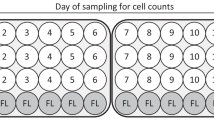Abstract
Chlorophyll a (Chl a) is the predominant pigment in every single photosynthesizing organism including phytoplankton and one of the most commonly measured water quality parameters. Various methods are available for Chl a analysis, but the majority of them are of limited throughput and require considerable effort and time from the operator. The present study describes a high-throughput, microplate-based fluorometric assay for rapid quantification of Chl a in phytoplankton extracts. Microplate sealing combined with ice cooling was proved an effective means for diminishing solvent evaporation during sample loading and minimized the analytical errors involved in Chl a measurements with a fluorescence microplate reader. A set of operating parameters (settling time, detector gain, sample volume) were also optimized to further improve the intensity and reproducibility of Chl a fluorescence signal. A quadratic regression model provided the best fit (r 2 = 0.9998) across the entire calibration range (0.05–240 pg μL−1). The method offered excellent intra- and interday precision (% RSD 2.2 to 11.2%) and accuracy (% relative error −3.8 to 13.8%), while it presented particularly low limits of detection (0.044 pg μL−1) and quantification (0.132 pg μL−1). The present assay was successfully applied on marine phytoplankton extracts, and the overall results were consistent (average % relative error −14.8%) with Chl a concentrations (including divinyl Chl a) measured by high-performance liquid chromatography (HPLC). More importantly, the microplate-based method allowed the analysis of 96 samples/standards within a few minutes, instead of hours or days, when using a traditional cuvette-based fluorometer or an HPLC system.

TChl a concentrations (i.e. sum of Chl a and divinyl Chl a in ng L-1) measured in seawater samples by HPLC and fluorescence microplate reader.





Similar content being viewed by others
References
Field CB, Behrenfeld MJ, Randerson JT, Falkowski P. Primary production of the biosphere: integrating terrestrial and oceanic components. Science. 1998;281(5374):237–40.
Weber T, Cram JA, Leung SW, DeVries T, Deutsch C. Deep ocean nutrients imply large latitudinal variation in particle transfer efficiency. Proc Natl Acad Sci U S A. 2016;113(31):8606–11.
Xiao X, Sogge H, Lagesen K, Tooming-Klunderud A, Jakobsen KS, Rohrlack T. Use of high throughput sequencing and light microscopy show contrasting results in a study of phytoplankton occurrence in a freshwater environment. PLoS One. 2014;9(8):e106510. doi:10.1371/journal.pone.0106510.
Gregg WW, Rousseaux CS. Decadal trends in global pelagic ocean chlorophyll: a new assessment integrating multiple satellites, in situ data, and models. J Geophys Res Oceans. 2014;119(9):5921–33.
Sauzède R, Lavigne H, Claustre H, Uitz J, Schmechtig C, D’Ortenzio F, Guinet C, Pesant S. Vertical distribution of chlorophyll a concentration and phytoplankton community composition from in situ fluorescence profiles: a first database for the global ocean. Earth Syst Sci Data. 2015;7(2):261–73.
Lagaria A, Mandalakis M, Mara P, Frangoulis C, Karatsolis B-TH, Pitta P, Triantaphyllou M, Tsiola A, Psarra S. Phytoplankton variability and community structure in relation to hydrographic features in the NE Aegean frontal area (NE Mediterranean Sea). Cont Shelf Res. 2016; doi:10.1016/j.csr.2016.07.014.
Schagerl M, Künzl G. Chlorophyll a extraction from freshwater algae—a reevaluation. Biologia. 2007;62(3):270–5.
Latasa M. A simple method to increase sensitivity for RP-HPLC phytoplankton pigment analysis. Limnol Oceanogr Methods. 2014;12(1):46–53.
Welschmeyer NA. Fluorometric analysis of chlorophyll a in the presence of chlorophyll b and pheopigments. Limnol Oceanogr. 1994;39(8):1985–92.
van Leeuwe MA, Villerius LA, Roggeveld J, Visser RJW, Stefels J. An optimized method for automated analysis of algal pigments by HPLC. Mar Chem. 2006;102(3–4):267–75.
Lagaria A, Mandalakis M, Mara P, Papageorgiou N, Pitta P, Tsiola A, Kagiorgi M, Psarra S. Phytoplankton response to Saharan dust depositions in the eastern Mediterranean Sea: a mesocosm study. Front Mar Sci. 2017; doi:10.3389/fmars.2016.00287.
Ashour MB, Gee SJ, Hammock BD. Use of a 96-well microplate reader for measuring routine enzyme activities. Anal Biochem. 1987;166(2):353–60.
Petihakis G, Drakopoulos P, Nittis K, Zervakis V, Christodoulou C, Tziavos C. M3A system (2000–2005)—operation and maintenance. Ocean Sci. 2007;3(1):117–28. http://www.ocean-sci.net/3/117/2007/
Peterson J, Nguyen J. Comparison of absorbance and fluorescence methods for determining liquid dispensing precision. J Am Lab Autom. 2005;10(2):82–7.
Colella S, Falcini F, Rinaldi E, Sammartino M, Santoleri R. Mediterranean ocean colour chlorophyll trends. PLoS One. 2016;11(6):e0155756. doi:10.1371/journal.pone.0155756.
Tiwari G, Tiwari R. Bioanalytical method validation: an updated review. Pharm Methods. 2010;1(1):25–38.
Burt SM, Carter TJN, Kricka LJ. Thermal characteristics of microtitre plates used in immunological assays. J Immunol Methods. 1979;31(3–4):231–6.
Holm-Hansen O, Lorenzen CJ, Holmes RW, Strickland JDH. Fluorometric determination of chlorophyll. ICES J Mar Sci. 1965;30(1):3–15.
Axler RP, Owen CJ. Measuring chlorophyll and phaeophytin: whom should you believe? Lake Reserv Manage. 1994;8(2):143–51.
Mallows CL. Some comments on Cp. Technometrics. 1973;15(4):661–75.
Smith K, Webster L, Bresnan E, Fraser S, Hay S, Moffat C. A review of analytical methodology used to determine phytoplankton pigments in the marine environment and the development of an analytical method to determine uncorrected chlorophyll a, corrected chlorophyll a and phaeophytin a in marine phytoplankton. Fisheries Research Services Internal Report, No 03/07; 2007. http://www.gov.scot/uploads/documents/ir0307.pdf.
Acknowledgements
The study was financially supported by a mobility grant under the EU Erasmus+ Programme for Higher Education, as well as from the EU-FP7 SeaBioTech project (Grant Number 311932). We thank the HCMR POSEIDON system team for providing the seawater samples from the E1-M3A site.
Author information
Authors and Affiliations
Corresponding author
Ethics declarations
Conflict of interest
The authors declare that they have no conflict of interest.
Ethical approval
This article does not contain any research with human or animal subjects.
Electronic supplementary material
ESM 1
(PDF 704 kb)
Rights and permissions
About this article
Cite this article
Mandalakis, M., Stravinskaitė, A., Lagaria, A. et al. Ultrasensitive and high-throughput analysis of chlorophyll a in marine phytoplankton extracts using a fluorescence microplate reader. Anal Bioanal Chem 409, 4539–4549 (2017). https://doi.org/10.1007/s00216-017-0392-9
Received:
Revised:
Accepted:
Published:
Issue Date:
DOI: https://doi.org/10.1007/s00216-017-0392-9




